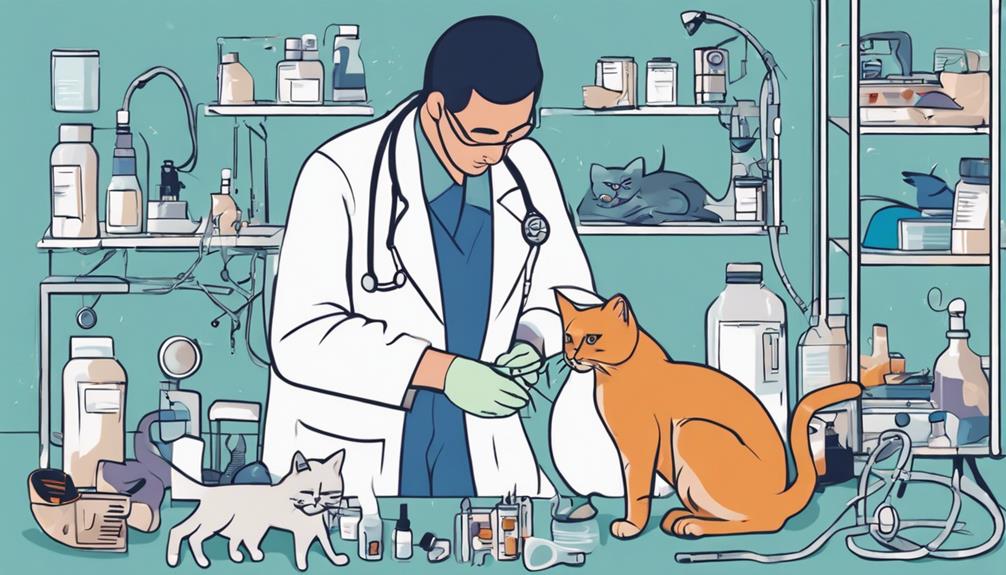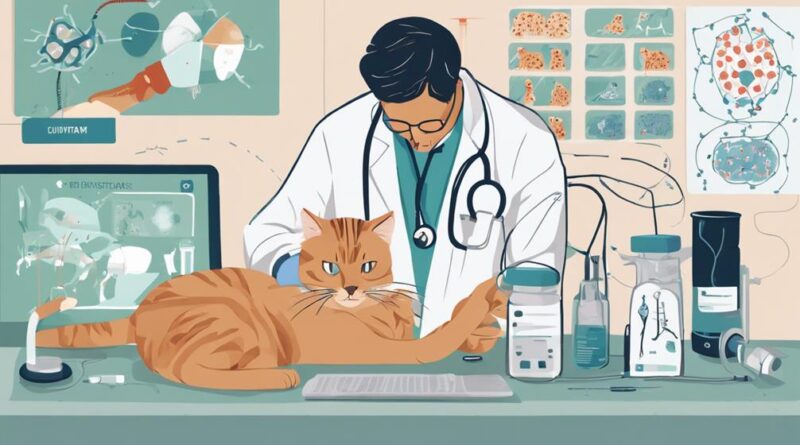10 Best Insights Into Feline Calicivirus
When it comes to understanding feline calicivirus, you might be surprised by the depth of insights available. From how it spreads to the latest treatment options, each aspect sheds light on managing this common feline disease.
As you explore these ten best insights, you'll uncover practical strategies that could make a significant difference in the health and well-being of your beloved feline companion.
Overview of Feline Calicivirus
Feline Calicivirus is a common viral infection in cats that affects the respiratory system and can lead to various symptoms. This virus has been a subject of interest in the field of molecular biology due to its intriguing features and viral evolution. Understanding the molecular biology of Feline Calicivirus is crucial in devising effective treatment strategies and preventive measures.
The study of Feline Calicivirus at a molecular level has revealed fascinating insights into its genetic makeup and how it evolves over time. Viral evolution plays a significant role in the survival and persistence of Feline Calicivirus in cat populations. By analyzing the genetic sequences of different viral strains, researchers can track how the virus mutates and adapts to its environment.
Through the lens of molecular biology, scientists have been able to unravel the complexities of Feline Calicivirus and its interactions with the host's immune system. This knowledge is essential for developing vaccines that can target specific viral components and prevent infection. Additionally, studying viral evolution provides valuable information on how Feline Calicivirus may evolve in the future, allowing for proactive measures to be implemented to control its spread.
Transmission and Spread
Understanding how Feline Calicivirus is transmitted and spreads is crucial in implementing effective control measures. The transmission dynamics of Feline Calicivirus are influenced by various environmental factors. The virus can survive for extended periods in the environment, especially in areas with high humidity and moderate temperatures. Contaminated surfaces such as food dishes, litter boxes, and bedding can serve as reservoirs for the virus, facilitating its spread among cats.
Host susceptibility plays a significant role in the transmission of Feline Calicivirus. Kittens, elderly cats, and immunocompromised individuals are more susceptible to infection. Cats with weakened immune systems aren't only more likely to contract the virus but also to shed it for longer periods, contributing to the spread of the disease within a population. Viral shedding patterns vary among infected cats, with some being asymptomatic carriers capable of spreading the virus unknowingly.
Implementing strict hygiene measures, such as regular disinfection of surfaces and equipment, can help reduce the environmental spread of Feline Calicivirus. Additionally, isolating infected cats and minimizing their contact with healthy individuals can prevent the transmission of the virus. Understanding the interplay between environmental factors, host susceptibility, and viral shedding patterns is essential for controlling the spread of Feline Calicivirus within multi-cat environments.
Symptoms and Clinical Signs
Recognizing the symptoms and clinical signs of Feline Calicivirus infection is crucial for timely intervention and management. Respiratory distress is a common initial symptom seen in cats infected with Feline Calicivirus. Cats may exhibit signs such as sneezing, nasal discharge, and difficulty breathing. These respiratory symptoms can vary in severity, with some cats developing mild congestion while others may experience more severe breathing difficulties. It's essential to monitor any changes in your cat's breathing pattern and seek veterinary care if you notice persistent respiratory distress.
Another hallmark symptom of Feline Calicivirus infection is the development of oral ulcers. These ulcers can appear on the tongue, gums, or roof of the mouth and may cause discomfort for the affected cat. Cats with oral ulcers may drool excessively, have trouble eating, or show reluctance to groom themselves due to the pain associated with the sores. If you observe any signs of oral ulcers in your cat, it's important to have them examined by a veterinarian promptly.
Diagnosis and Testing
To determine if your cat has Feline Calicivirus, veterinarians typically perform diagnostic tests to confirm the infection. Diagnostic techniques play a crucial role in identifying the presence of the virus in your feline friend. One common testing method is polymerase chain reaction (PCR) testing, which detects the genetic material of the virus in your cat's body. This method is highly sensitive and specific, providing accurate results.
In addition to PCR testing, veterinarians may also use serological testing to detect antibodies against the virus in your cat's blood. This can indicate a current or past infection with Feline Calicivirus. Serological testing is valuable for understanding the immune response to the virus and assessing the level of protection in your cat.
Furthermore, clinical signs and symptoms such as oral ulcers, respiratory distress, and lameness can guide veterinarians in diagnosing Feline Calicivirus. However, these signs alone aren't definitive, highlighting the importance of specific diagnostic tests.
Treatment Options Available
When treating Feline Calicivirus in your cat, veterinarians typically focus on alleviating symptoms and providing supportive care to aid in recovery. Here are some treatment options available for your feline friend:
- Supportive Care: Providing your cat with supportive care such as ensuring they're well-hydrated and maintaining their nutrition is crucial for their recovery.
- Antiviral Medications: Veterinarians may prescribe antiviral medications to help combat the Feline Calicivirus infection and reduce its severity.
- Vaccination Updates: Ensuring your cat's vaccinations are up to date can help prevent Feline Calicivirus infection or reduce the severity of symptoms if they do contract the virus.
- Alternative Therapies: Some alternative therapies like herbal supplements or immune-boosting treatments may be used in conjunction with traditional treatments to support your cat's immune system during recovery.
It is important to consult with your veterinarian to determine the best course of treatment for your cat. By following their recommendations and providing your cat with the necessary care, you can help them recover from Feline Calicivirus more effectively.
Prevention Strategies
To prevent Feline Calicivirus in your cat, implementing effective prevention strategies is essential for maintaining your cat's health and well-being. One of the most crucial prevention strategies is vaccination. Vaccines have shown significant effectiveness in reducing the severity of the disease and preventing infection. By ensuring your cat is up to date on their vaccinations, you not only protect them but also contribute to herd immunity, which helps safeguard the overall feline population.
In addition to vaccination, practicing proper environmental disinfection is key. Regularly cleaning and disinfecting your cat's living areas, food and water bowls, and toys can help eliminate the virus and reduce the risk of transmission. Implementing quarantine protocols is also essential, especially if you have multiple cats. If one cat is infected, separating them from healthy cats can prevent the spread of the virus within your household.
Managing Infected Cats

Effective management of infected cats with Feline Calicivirus requires prompt veterinary intervention and strict isolation protocols to prevent further transmission within your household. Upon diagnosis, it's crucial to take immediate action to safeguard the health of your infected cat as well as other feline companions. Here are some key strategies to manage infected cats:
- Quarantine Measures: Isolate the infected cat in a separate room with dedicated food and water bowls, litter box, and bedding. Ensure strict hygiene practices when interacting with the infected cat to prevent the spread of the virus.
- Holistic Approaches: Consider holistic treatment options such as immune-boosting supplements or herbal remedies to support your cat's immune system during the recovery process.
- Nutrition: Provide a balanced and nutritious diet tailored to meet the specific needs of your infected cat. Consult with your veterinarian for recommendations on the best diet to support your cat's health.
- Environmental Enrichment: Keep your infected cat mentally stimulated and engaged by providing toys, scratching posts, and interactive play sessions. Environmental enrichment can help alleviate stress and promote overall well-being during the recovery period.
Future Research and Developments
Exploring new avenues for research and advancements in feline calicivirus is essential to enhancing our understanding of this viral infection and improving treatment strategies. In the realm of future research, studying viral evolution is crucial to stay ahead of feline calicivirus mutations. By tracking how the virus changes over time, researchers can anticipate potential shifts in virulence, transmissibility, and resistance to treatments. Understanding viral evolution can also help in developing more targeted and effective antiviral therapies to combat the ever-changing nature of feline calicivirus.
Another key area for future research is vaccine development. Creating a safe and efficient vaccine against feline calicivirus is paramount in preventing infections and reducing the severity of the disease in cats. Scientists are continuously working to enhance existing vaccines or develop new ones that offer broader protection against different strains of the virus. Improvements in vaccine technology, such as the use of novel adjuvants or delivery systems, can help boost immune responses and increase vaccine efficacy.
Frequently Asked Questions
Can Feline Calicivirus Be Transmitted to Other Animals Besides Cats?
Feline calicivirus can be transmitted to other animals besides cats. Cross-species transmission is possible, increasing zoonotic potential.
Environmental factors like shared living spaces or contaminated objects can facilitate spread.
To prevent transmission, ensure infected cats are isolated, practice good hygiene, and disinfect commonly used surfaces.
Are There Any Natural Remedies or Alternative Treatments That Can Help Alleviate Symptoms of Feline Calicivirus?
If you're looking for ways to help your cat feel better from feline calicivirus, consider trying herbal remedies, dietary supplements, acupuncture, or homeopathy. These alternative treatments may help alleviate symptoms and support your cat's immune system.
Always consult with a vet to ensure these options are safe and appropriate for your furry friend's specific situation. Remember, natural remedies can be a complementary approach to veterinary care in managing feline calicivirus symptoms.
Is It Possible for Cats to Develop Immunity to Feline Calicivirus After Being Infected Once?
Yes, cats can develop immunity to feline calicivirus after being infected once. However, this doesn't guarantee complete protection as the virus can mutate, leading to reinfection.
Vaccines can help boost immunity levels, but their effectiveness may vary due to virus mutations.
It's important to monitor your cat's health and consult a veterinarian for the best course of action to protect against feline calicivirus.
Can Feline Calicivirus Be Passed From a Mother Cat to Her Kittens During Birth or Through Nursing?
Feline calicivirus can be passed from a mother cat to her kittens during birth or through nursing, known as vertical transmission. Kittens are at risk of neonatal infection this way. While some immunity may be passed from the mother, preventing infection is crucial.
Ensure the mother is healthy and vaccinated to reduce the risk. Regular vet check-ups and vaccinations for both mother and kittens can help protect against feline calicivirus transmission.
Are There Any Long-Term Effects or Complications Associated With Feline Calicivirus Infection in Cats?
Long term effects and complications of feline calicivirus infection in cats can vary. Some cats may develop chronic symptoms like oral ulcers, pneumonia, or joint pain. In severe cases, kidney or liver damage can occur.
Monitoring your cat's health regularly and seeking veterinary care for persistent issues is crucial. Vaccination and good hygiene practices can help prevent the spread of the virus and reduce the risk of complications.
Conclusion
In conclusion, understanding feline calicivirus is crucial for the health and well-being of our beloved feline companions. By recognizing the transmission, symptoms, and treatment options available, we can better prevent and manage this common viral infection in cats.
With ongoing research and developments, we can continue to improve our knowledge and care for cats affected by feline calicivirus. Stay informed and proactive in keeping your furry friends healthy and happy.
